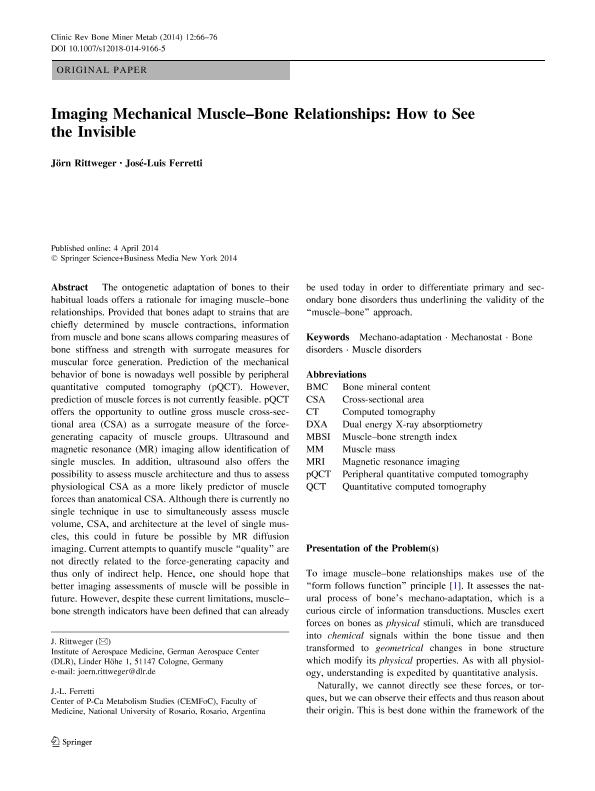Mostrar el registro sencillo del ítem
dc.contributor.author
Rittweger, Jorn
dc.contributor.author
Ferretti, Jose Luis

dc.date.available
2017-12-18T13:52:39Z
dc.date.issued
2014-06
dc.identifier.citation
Rittweger, Jorn; Ferretti, Jose Luis; Imaging Mechanical Muscle–Bone Relationships: How to See the Invisible; Springer; Journal of Musculoskeletal and Neuronal Interactions; 12; 2; 6-2014; 66-76
dc.identifier.issn
1108-7161
dc.identifier.uri
http://hdl.handle.net/11336/30849
dc.description.abstract
The ontogenetic adaptation of bones to their habitual loads offers a rationale for imaging muscle–bone relationships. Provided that bones adapt to strains that are chiefly determined by muscle contractions, information from muscle and bone scans allows comparing measures of bone stiffness and strength with surrogate measures for muscular force generation. Prediction of the mechanical behavior of bone is nowadays well possible by peripheral quantitative computed tomography (pQCT). However, prediction of muscle forces is not currently feasible. pQCT offers the opportunity to outline gross muscle cross-sectional area (CSA) as a surrogate measure of the force-generating capacity of muscle groups. Ultrasound and magnetic resonance (MR) imaging allow identification of single muscles. In addition, ultrasound also offers the possibility to assess muscle architecture and thus to assess physiological CSA as a more likely predictor of muscle forces than anatomical CSA. Although there is currently no single technique in use to simultaneously assess muscle volume, CSA, and architecture at the level of single muscles, this could in future be possible by MR diffusion imaging. Current attempts to quantify muscle “quality” are not directly related to the force-generating capacity and thus only of indirect help. Hence, one should hope that better imaging assessments of muscle will be possible in future. However, despite these current limitations, muscle–bone strength indicators have been defined that can already be used today in order to differentiate primary and secondary bone disorders thus underlining the validity of the “muscle–bone” approach.
dc.format
application/pdf
dc.language.iso
eng
dc.publisher
Springer

dc.rights
info:eu-repo/semantics/openAccess
dc.rights.uri
https://creativecommons.org/licenses/by-nc-sa/2.5/ar/
dc.subject
Mechano-Adaptation
dc.subject
Mechanostat
dc.subject
Bone Disorders
dc.subject
Muscle Disorders
dc.subject.classification
Salud Ocupacional

dc.subject.classification
Ciencias de la Salud

dc.subject.classification
CIENCIAS MÉDICAS Y DE LA SALUD

dc.title
Imaging Mechanical Muscle–Bone Relationships: How to See the Invisible
dc.type
info:eu-repo/semantics/article
dc.type
info:ar-repo/semantics/artículo
dc.type
info:eu-repo/semantics/publishedVersion
dc.date.updated
2017-12-07T15:40:19Z
dc.journal.volume
12
dc.journal.number
2
dc.journal.pagination
66-76
dc.journal.pais
Grecia

dc.journal.ciudad
Kifissia
dc.description.fil
Fil: Rittweger, Jorn. German Aerospace Agency; Alemania
dc.description.fil
Fil: Ferretti, Jose Luis. Universidad Nacional de Rosario. Facultad de Ciencias Médicas. Centro de Estudios de Metabolismo Fosfocálcico; Argentina. Consejo Nacional de Investigaciones Científicas y Técnicas; Argentina
dc.journal.title
Journal of Musculoskeletal and Neuronal Interactions
dc.relation.alternativeid
info:eu-repo/semantics/altIdentifier/url/https://link.springer.com/article/10.1007/s12018-014-9166-5
Archivos asociados
